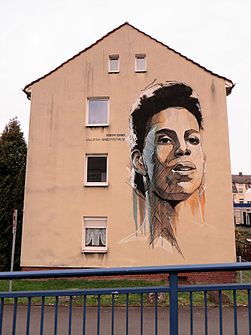Eckesey
|
Eckesey
City of Hagen
Coordinates: 51 ° 22 ′ 55 ″ N , 7 ° 27 ′ 15 ″ E
|
|
|---|---|
| Height : | 98 m above sea level NHN |
| Residents : | 8145 (December 31, 2015) |
| Incorporation : | April 1, 1901 |
| Postal code : | 58089 |
| Area code : | 02331 |
|
Street art at house Schillerstraße 2 in Eckesey
|
|
Eckesey is a district of the independent Westphalian city of Hagen , in the eastern Ruhr area .
location
To the west, the district is bounded by the course of the river Volme , by the federal road 54 running from the city center towards the vestibule , by the ridge that runs north of the Philippshöhe from the Osterhalle (249.5 m) to the Hallerkopp (215.8 m ) and through a freight train track that runs north from the western part of the main station.
To the east, the district is bounded by a wide long-distance rail band, on the eastern side of which the districts of Altenhagen and Boelerheide connect, and on whose rails the intercity trains from Hagen from Dortmund and the regional trains to Bochum, Herdecke and Schwerte move .
history
With the name "Eckesey" there is now broad agreement that the first syllable "corner" is derived from the Low German "oak", while "Ey" probably stands for a "damp meadow". Eckesey is thus an area that lies in the floodplain of a river, namely the Volme , and is covered with oaks. In addition to this explanation, there is also the legend that the only surviving couple after the plague and war, when asked who would have survived in this area, answered: "Eck un sey" (me and her).
The Eckesey court was first mentioned in a document in 1296 as the lower courtyard of the Eilpe main courtyard , owned by Deutz Abbey . The Eckesey peasantry belonged to the county of Mark in the parish and court of Hagen . In the treasury of Grafschaft Mark from 1486, 11 taxable farm owners are named in the Eckeseyer Burschop with a tax between ½ Gg and 6 gold guilders .
In the 18th century there were two main settlement areas in the valley of the Volme in addition to a few farms and cottages: namely around the Altenhagen manor in the Altenhagener Brücke and Strasse area and on the Geitebrücke and upper Eckeseyer Strasse. The largest farms belonged to the farmers Refflinghaus (Brüderstraße), Schulte / Beckmann (Droste Hülshoff-Straße) and Rath (Eckeseyer Straße).
Very early on, factories settled along the Volme, using weirs, ditches and ponds to use the power of flowing water for iron processing. The construction of the Bergisch-Märkische Eisenbahn (1848) and the Rheinische Bahn (1879) cut the grown structures, but also led to the rapid development of industry and the influx of workers. The southern part of Eckeseys became an industrial area on both sides and between the rails, while the northern part was transformed by housing. Brick factories were now being built in various places that extracted clay and processed it into building blocks. The headquarters of the confectionery manufacturer Villosa was located in Eckesey , and in 1824 the foundation stone for the Schmiedag drop forge was laid here.
On April 1, 1901, the municipality of Eckesey / Altenhagen was merged with the municipality of Hagen, after it had previously belonged to the Boele-Hagen district in the Hagen district. Today Eckesey belongs administratively together with Vorhalle, Bathey, Boele, Boelerheide and Helfe to the Hagen district north. On August 26, 1965, the then Mayor of Berlin, Willy Brandt, visited the city of Hagen for an election campaign appearance on Wielandplatz in the working-class district of Eckesey and spoke to several hundred people.
population
Today Eckesey is a purely residential area with a Muslim influence, as many immigrants of Turkish origin live there. According to information from the Statistics, Urban Research and Elections Department, on December 31, 2015, there were 2,677 inhabitants in Eckesey-Nord, 1,863 Germans, and in Eckesey-Süd 5,468, including 3,455 Germans.
The Catholic parish of St. Petrus Canisius and the Protestant Melanchthon parish are located in Eckesey, as is the Turkish-Islamic Cultural Association with the Mevlana Mosque.
The active clubs in Eckesey include the girls' choir " Die Hagener Volmespatzen ", the Geitebrücker Schützenverein, the handball players of TuRa 1872 Hagen, and the popular and competitive athletes of TUS Eintracht 02 Eckesey.
Individual evidence
- ^ Statistical Office of the City of Hagen
- ↑ Ralf Blank / Stephanie Marra / Gerhard E. Solbach: Hagen - history of a large city and its region , Klartext Verlag, Essen 2008, page 88
- ^ A. Meister (Ed.): Die Grafschaft Mark , Dortmund 1909, page 50
- ↑ Schmiedag ( Memento of the original from April 13, 2016 in the Internet Archive ) Info: The archive link was inserted automatically and has not yet been checked. Please check the original and archive link according to the instructions and then remove this notice.
- ↑ Stephanie Reekers: The regional development of the districts and communities of Westphalia 1817-1967 . Aschendorff, Münster Westfalen 1977, ISBN 3-402-05875-8 , p. 229 .
- ↑ Willy Brandt in Eckesey is celebrating the 50th anniversary of the SPD Hagen on August 26, 2015
Web links
- Homepage Hagen-Eckesey
- Jens Bergmann: Eckesey - attempt at a demarcation
- Railway depot Hagen-Eckesey
- The name Eckesey from: Dirk Sondermann, Ruhrsagen (2005) ISBN 3-922750-60-5
- Rhenish line, Hagen-Eckesey station

